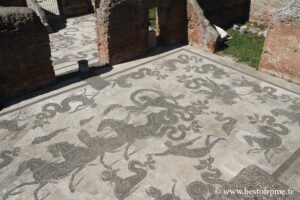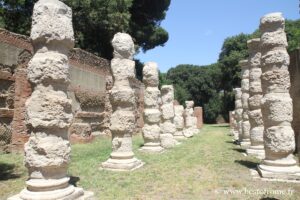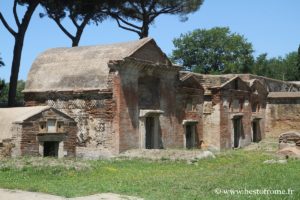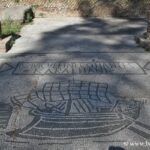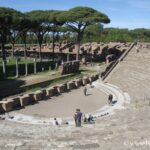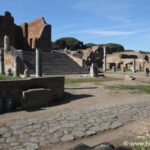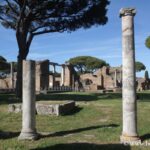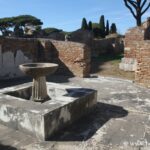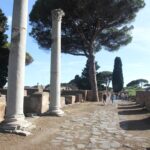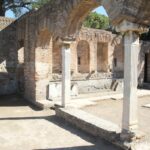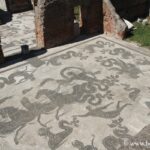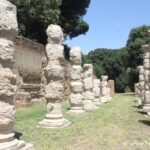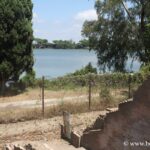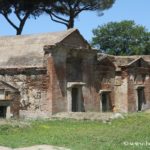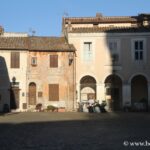Ostia was the port that served ancient Rome, located at the mouth of the Tiber. The beautiful archaeological site of this port city (the Scavi di Ostia Antica) is located in Ostia Antica, name taken by the small medieval village nearby to distinguish it from the modern city of Ostia located towards the coast.
Almost 20 kilometres from Rome, it is one of the most beautiful Roman sites in the region. It deserves a visit in more ways than one, as much for its archaeological interest and scale, as for the pleasant and relaxing setting. It is also the second largest archaeological park in Italy after Pompeii, which extends beyond the ancient port city proper of the Scavi di Ostia Antica, with also the sites on the Fiumicino city of the Imperial Harbours of Claudius and Trajan, the Necropolis of the sacred island, or the Roman Ships Museum.
Archaeological site of Ostia Antica
The port of Ostia was active from the time of the Roman Republic. After the construction of the neighboring Harbours of Claudius and Trajan, it still remained an important residential and administrative center, with nearly 50,000 inhabitants.
The ruins of the city are now two kilometers from the coast due to 2000 years of sedimentation. Its archaeological site (Scavi di Ostia Antica) is a delight, offering a beautiful immersion in Roman antiquity. It preserves many houses and public monuments, constituting a remarkable testimony of Roman life.
The oldest remains are those of a tuff castrum from the 4th century BC. The most beautiful buildings date back to the greatest prosperity of the port city, in the 2nd century AD, when the Forum, the baths, horra (warehouses), scholae were built (seats of professional guides), insulae (large apartment buildings) and the Capitolium with the main temple. The pretty Roman theatre dates from the end of the 1st century with Augustus. It hosts shows in summer.
Harbours of Claudius and Trajan
With the sinking of the port of Ostia and its limited capacity, Claudius built a new harbour between 42 and 64 A.D. large. It was further enlarged in the 2nd century by Trajan who added a vast hexagonal basin of 33 hectares, large canals, and huge warehouses. There are still beautiful remains of these structures, including for the harbour of Claudius the foundations of the quays, the canals, the captaincy, buildings like baths. From the harbour of Trajan, you can see the basin, a large canal, the vast storage warehouse structures or those of the imperial palace.
This interesting archaeological area lies between the archaeological site of Ostia antica and the infrastructure of Fiumicino airport.
Nearby is the Roman Ships Museum (Museo delle Navi di Fiumicino) where the remains of five wooden hulls of Roman ships (2nd to 5th centuries) are preserved, found during the construction of the airport.
Necropolis of Portus
This remarkable necropolis (Necropoli di Porto all’Isola Sacra) was revealed during excavations with the sanitation of the “sacred island” from 1925.
On 400 meters are nearly 150 graves, with beautiful conservations, built after the creation of the port of Claude, between Porto (Harbours of Claudius and Trajan) and Ostia. It is dominated by family-style tombs with square chambers, with niches for urns, decorated with mosaics, vaults, stucco, with brick facades decorated with pilasters, pediments, inscriptions, etc.
Ostia Antica Village
The pleasant little village of Ostia Antica is marked by medieval times. It developed around a Christian necropolis of the imperial era, with the construction of a fortified citadel in the 9th century. It was transformed into a beautiful Renaissance castle, the Castle of Julius II, built in the 15th century, surrounded by a moat and with three dungeons.
Lido di Ostia and Cancelli beaches
Lido di Ostia is a seaside town dating back to the early twentieth century with its seafront and many establishments and bars, as well as the district of Borghetto dei Pescatori, former fishing village between the coast and the pine forest.
On a 5 km coastal strip, towards the south-east, the “Cancelli” are vast beaches with their sand dunes.
More informations and links
- On the official Archaeological Park of Ostia antica : ostia antica, imperial harbours of Trajan and Claudius, necropolis of Porto, museum of Roman ships
- On Wikipedia : Ostia antica
Guided tours and visits
Proposals for guided tours in Ostia
Map
If you see this after your page is loaded completely, leafletJS files are missing.
Gallery
- Forum of Corporations
- Theatre of Ostia
- Forum with Capitole
- Ostia antica
- Roman houses
- Paved streets
- Roman villas in Ostia
- Neptune mosaics
- Portico of the port of Claude
- Port of Trajan
- Necropolis of Portus in the Isola Sacra
- Borgo of Ostia Antica









